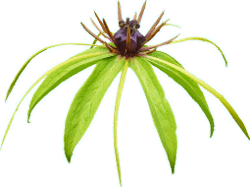
Paris polyphylla

David has announced that this was the last tour he's going to organise. It was well up to his usual high standard, and enjoyed by everyone despite the appearance of umbrellas and waterproofs in many of the gardens. Garden owners told us they were very pleased to see the rain: our preference would definitely have been for a few more days' dry weather. But all of us who have been on the tours thank him for ensuring that they have been such splendid events.
As well as the gardens for which reports follow, we visited Wakehurst Place, Great Dixter and Sissinghurst. These three famous gardens have all been written about at length and reports therefore seemed unnecessary. It also seemed most unfair to ask anyone to write a short report about them! There are photos of all the gardens, with thanks to Leila, Wendy and Ann Hooper for their contributions.
Graham, our ‘peerless’ driver once more, faced his first challenge of the trip as the entrance to Grove Farm seemed no more than six inches wider than the coach and led into an equally narrow sunken lane curving downhill. From the drive we looked down on clipped hedges and a maze. The Gibson family has owned Grove Farm for 18 years and 15 years ago Head Gardener Tom, who began his career with Cheltenham Parks and trained at Pershore, laid out the maze using 1,000 small plants - end to end, it is a quarter of a mile long. The garden had an immediate feeling of modern formality: I was reminded a little of Stanbridge Mill in Dorset.
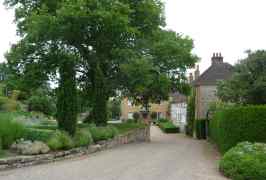
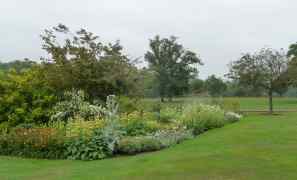 Maintained organically, the garden faces south with views of the Downs (not on our visit!): to make the most of the views a ha-ha separates garden from fields, and to make the most of the drop between, an array of solar panels has been installed. The house is partly hung in the local style with orangey-tan tiles, so the use of white, yellow and blue in the borders enhances rather than clashes with it. A variegated tracheospermum on the south wall of the house was very pretty.
Maintained organically, the garden faces south with views of the Downs (not on our visit!): to make the most of the views a ha-ha separates garden from fields, and to make the most of the drop between, an array of solar panels has been installed. The house is partly hung in the local style with orangey-tan tiles, so the use of white, yellow and blue in the borders enhances rather than clashes with it. A variegated tracheospermum on the south wall of the house was very pretty.
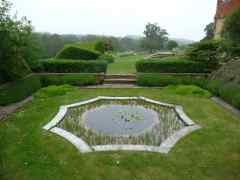
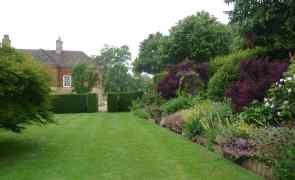 A curved octagonal pond and a border of yellow and deep purple were both a little unusual, but worked. The red plastic bench in front of a grey plastic wall at the end of a hornbeam allee were more doubtful: better from a distance. A wildflower meadow and fruit garden were to one side of the maze, with a kitchen garden on two terraces to the other. Tom keeps trying sweet potatoes, so far without success. The maze itself proved most entertaining, both for those brave souls who ventured into it and for those who stood on the hillside above and watched them.
A curved octagonal pond and a border of yellow and deep purple were both a little unusual, but worked. The red plastic bench in front of a grey plastic wall at the end of a hornbeam allee were more doubtful: better from a distance. A wildflower meadow and fruit garden were to one side of the maze, with a kitchen garden on two terraces to the other. Tom keeps trying sweet potatoes, so far without success. The maze itself proved most entertaining, both for those brave souls who ventured into it and for those who stood on the hillside above and watched them.
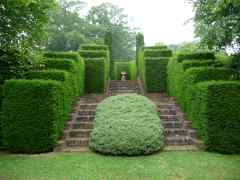
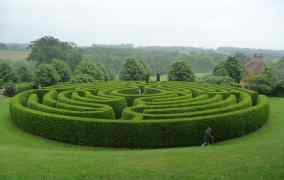
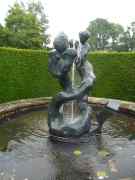 Hedges of all sizes are the boundaries within the garden: these are cut once a year, after August, as there is no regrowth after the beginning of August.
Hedges of all sizes are the boundaries within the garden: these are cut once a year, after August, as there is no regrowth after the beginning of August.
A look at the knot garden, herbs edged in blue box, took us back to the drive. The lake on the other side of the drive is very much a work in progress. Before we left some of us admired the local wooden fencing style: uprights and two rails of uneven timber which we saw widely during our tour, and some went to inspect the reportedly ‘enormous’ compost heap.
We left Tunbridge Wells on Thursday at 9.15am for a 36-minute drive and one and three quarters of an hour later, we arrived. As we travelled round the area the storm clouds collected above and inside the coach.
It was with great relief that we walked down the short drive lined with lawns and a border of white and pale peach hollyhocks
to the nerve centre of Sarah Raven Enterprises. The site is two acres on the brow of a hill; the house is of mellow brick and in need of some TLC. It is covered with climbers and undergrowth. Past the house we climbed up a grass path through the south facing raised beds in which the vegetables were growing, to a magnificent, huge glasshouse.
This housed the shop, workrooms, lecture theatre and a conservatory full of fruit, vegetables and flowers grown in pots or beds.
The young enthusiastic staff greeted us with coffee and then took us on a tour. The whole place buzzed with colour, excitement and happenings. The two full-time gardeners described the area as a glorified allotment. It is very labour intensive: as one crop finishes another is planted - the soil is refreshed at each planting (mushroom compost). All produce is grown to supply the courses run on site – flower arranging, cooking and soon Sarah’s latest interest, insects and wild flower gardening. There is a TV programme in the autumn, with accompanying book.
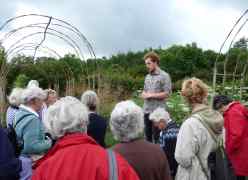
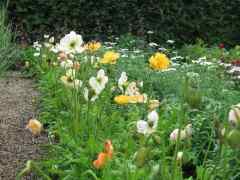 On our tour we visited the cutting garden with rows of deep blue delphiniums, Iceland poppies in pastel colours, white Orlaya grandiflora and sweet williams in vivid colour masses. The vegetable garden was equally busy with fruit and vegetables. The gardens round the house were all different: in the Oasthouse Garden there was an extravagant mix of colour, densely planted and fighting to reach the sky and fill the space. In contrast the Nectar Garden was more restrained but it was still being planted up. Nowhere did we see any yellow flowers. (Sarah does not like yellow.)
On our tour we visited the cutting garden with rows of deep blue delphiniums, Iceland poppies in pastel colours, white Orlaya grandiflora and sweet williams in vivid colour masses. The vegetable garden was equally busy with fruit and vegetables. The gardens round the house were all different: in the Oasthouse Garden there was an extravagant mix of colour, densely planted and fighting to reach the sky and fill the space. In contrast the Nectar Garden was more restrained but it was still being planted up. Nowhere did we see any yellow flowers. (Sarah does not like yellow.)
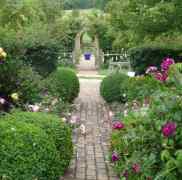
The rain arrived near the end of the tour and we rushed into the shop and set about a little retail therapy. No plants for sale but lots of seeds, vases, books, containers, cookery utensils and interesting presents. Sarah Raven has developed a very successful commercial enterprise, which all agreed was exciting, fun and gave us lots of good ideas for the garden.
On a grey day with the forecast rain just starting we arrived to a very warm welcome from Carolyn McCutchan and her daughter Phillippa. Fortified with coffee and delicious home-made shortbread we braved the weather.
Carolyn, who is Chairman of the Sussex Group of the HPS, has created her garden on two acres of heavy clay former farmland which surround the 18th century former gamekeeper’s cottage. The soil has been lightened over the years by the addition of large quantities of compost and now as time creeps on, large sections of lawn are being removed and replaced with bark chips in order to reduce the workload. Quite a few of the hardy plants we were shown came from Marchants Hardy Plants nursery which was our afternoon visit.
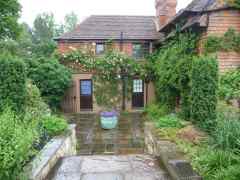 The garden is split into a series of areas surrounding the house, which was clothed on one side with a good specimen of the reliable repeat flowering rambling rose 'Phyllis Bide'. We started close to the house where there are a large number of tulips which Carolyn leaves in situ and adds to each year, carefully marking where new varieties are to go.
The garden is split into a series of areas surrounding the house, which was clothed on one side with a good specimen of the reliable repeat flowering rambling rose 'Phyllis Bide'. We started close to the house where there are a large number of tulips which Carolyn leaves in situ and adds to each year, carefully marking where new varieties are to go.
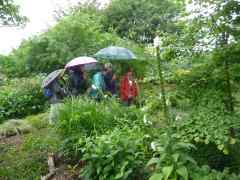
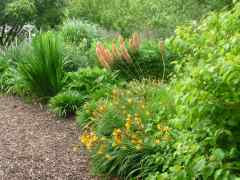 As we moved towards the winter garden we passed a group of Nicotiana suaveolens (seeds available from Thompson & Morgan), a delicate, scented variety new to me. Part of the winter garden used to be a pond for the animals but most has been filled in and only a small part remains. Small daffodils, in particular Narcissus cyclaminius types are used, and only white or cream foxgloves are allowed to flower. Hostas are gradually being replaced by ferns in this area.
As we moved towards the winter garden we passed a group of Nicotiana suaveolens (seeds available from Thompson & Morgan), a delicate, scented variety new to me. Part of the winter garden used to be a pond for the animals but most has been filled in and only a small part remains. Small daffodils, in particular Narcissus cyclaminius types are used, and only white or cream foxgloves are allowed to flower. Hostas are gradually being replaced by ferns in this area.
The adjacent conservation meadow has not been ploughed for many years and is now home to about 35 different species including adder’s tongue fern and orchids. In mid July it is cut for hay and grazed by sheep, which tread the seed into the ground, until Christmas.
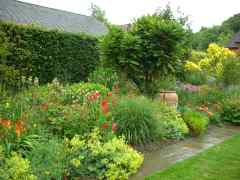
The octagonal Lawn Garden has large, very deep, colour-themed borders, still dominated by masses of alliums. Carolyn had been in the process of waging war on the alliums which have taken on the role of invasive weeds throughout the garden – several members were able to obtain some of these discarded bulbs! Filling the gap between early and late colour was the pale apricot hardy annual Collomia grandiflora (available from Chiltern seeds) which seeds itself freely through the borders but is easy to weed out where not needed.
By this time the rain had been hammering down for some time and most had retreated to any available shelter. Sadly, struggling to manage a notepad, pencil and umbrella has meant I really haven’t been able to do justice to a lovely garden. Eventually I gave up and joined the rest, steaming gently, in the garden room where we enjoyed a lovely lunch of homemade quiche and salad.
It was raining quite heavily when the coach arrived at Marchants Hardy Plants where Graham Gough and his wife were waiting to greet us. It was decided that in view of the weather it would be best if we toured the garden and nursery individually so that people could go back to the coach when they wished.
Most of the group made a beeline for the nursery, me included, as I was hoping to have better success in finding a plant I had been asked to look for here than I had in finding one at Great Dixter. I found it! The nursery was stocked with a well grown range of plants and Graham was at hand to offer descriptions and cultural instructions for them.
After choosing a selection of plants Veronica and I turned our attention to the garden. This comprised an area of mixed planting of shrubs, grasses and herbaceous plants in beds divided by various means including a curved beech hedge. The design and planting was very good, with several flowering kniphofia attracting attention. Beyond the beds was a more informal area including a pool and wildflower patches. A large clump of corncockle (Agrostemma githago) was in full flower at the entrance to this area. We went back to the nursery through a small orchard where a delicious perfume drew us to a white rose growing over a fence. I asked Graham about this rose and he said that it was called ‘Betty Sherriff’ and that it had been given to him by Jack Elliot, a past president of the HPS.
When we had boarded the coach and set off for Rose Cottage the rain came down even more heavily, prompting Veronica to say “Weren’t we lucky not to get any wetter than we did there”. Is that called looking on the bright side?
The owners have transformed a neglected two-thirds of an acre site over the past 17 years with informal and cottage style planting. The garden is on several levels and there are clematis and old roses intertwining throughout. There is a pond containing koi and a newer pond for wildlife. Ken, the owner, grows organic vegetables and is interested in 'heritage varieties', all of which are grown in raised beds, and he is experimenting with some grown in straw bales. A small polytunnel provides tomatoes, peppers and aubergines in the summer and salad crops in the winter.
Around the garden are sculptures by David Newman and a carved stone angel from a demolished church. It and other carvings were made by James Forsyth in the 1840s when Rose Cottage was built. Other home-made ‘sculptures’ represent the owner's quirky sense of humour. We were kindly served tea and cake which, on a showery day, was very welcome.
Rose Cottage: tel. 01825 830314. email: kenmines@hotmail.com
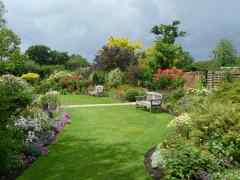 These lovely East Sussex gardens consist of four acres of densely planted borders, two small lakes, a wild flower meadow, a nursery, restaurant and gift shop, and many individual features. The business, established in the early 1990s, is family-owned and their eye for detail certainly shows in the way in which the gardens are laid out and meticulously maintained.
These lovely East Sussex gardens consist of four acres of densely planted borders, two small lakes, a wild flower meadow, a nursery, restaurant and gift shop, and many individual features. The business, established in the early 1990s, is family-owned and their eye for detail certainly shows in the way in which the gardens are laid out and meticulously maintained.
The beds
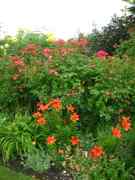
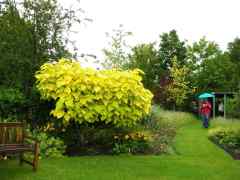 are beautifully colour co-ordinated: I was particularly impressed with the combinations of climbing roses and lilies in matching colours making dramatic statements. Catalpa bignonioides ‘Aurea’ trees were pruned to about 12 feet in several borders, each one under-planted with co-ordinating coloured perennials such as hemerocallis. There were a lot of other mature trees, which I love: in particular I liked a group of three silver birches planted in the centre of a lawn surrounding a round seat with an urn in the centre. Also, a grove of birches caught my attention with several large carved wooden mushrooms positioned underneath. Another catalpa at the far end of the garden was a variegated form – very unusual.
are beautifully colour co-ordinated: I was particularly impressed with the combinations of climbing roses and lilies in matching colours making dramatic statements. Catalpa bignonioides ‘Aurea’ trees were pruned to about 12 feet in several borders, each one under-planted with co-ordinating coloured perennials such as hemerocallis. There were a lot of other mature trees, which I love: in particular I liked a group of three silver birches planted in the centre of a lawn surrounding a round seat with an urn in the centre. Also, a grove of birches caught my attention with several large carved wooden mushrooms positioned underneath. Another catalpa at the far end of the garden was a variegated form – very unusual.
An impressive rill bordered with a mixture of grasses and anthemis gave a view through a ‘window’ in a hedge when viewed from one end, very imaginative. Nearby a newly planted gravel area with a large urn at its centre was simple but effective. Another ‘room’ was divided up by box hedges with some sections planted solely with different types of cabbage, different but eye-catching.
A shade area included many perfect hostas and a bog garden was planted with veronicastrum, irises, ligularia and other moisture loving plants. A small wild flower meadow included a group of insect ‘houses’, a bird hide provided a view of the birds feeding and also gave welcome shelter when the rain started! Various sculptures round the garden were well placed as were large pots, some simply used as features on their own.
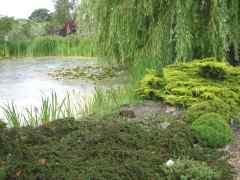
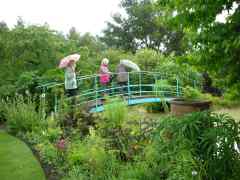
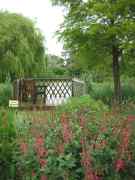 Two small lakes were surrounded by colourful planting including kniphofia, paeonia, sanguisorba, berkheya, phygelius and low growing conifers. A bridge crossed the waterfall between the lakes. This was the only aspect of the garden which I thought was not in keeping as it was painted blue which I know is an ‘in’ colour for garden features at the moment, but I find it intrusive. Another bridge in the tropical garden was natural wood which was much more appropriate.
Two small lakes were surrounded by colourful planting including kniphofia, paeonia, sanguisorba, berkheya, phygelius and low growing conifers. A bridge crossed the waterfall between the lakes. This was the only aspect of the garden which I thought was not in keeping as it was painted blue which I know is an ‘in’ colour for garden features at the moment, but I find it intrusive. Another bridge in the tropical garden was natural wood which was much more appropriate.
With a lovely eryngium in the blue garden, dianthus on the edges of many borders, water lilies on the lake, plenty of places to sit and contemplate, trees, shrubs, grasses and a magnificent array of herbaceous plants, this was definitely one of my favourite gardens of the trip.
To complete this delightful experience, a visit to the adjoining nursery was, of course, necessary. A display bed with plants currently performing at their best was on one side to whet the appetite and there was a large choice of plants to buy. Needless to say, I succumbed and added to the coach load with a berkheya (hope it survives next winter) and an Iris sibirica ‘Melton Red Flare’. Well, one has to have a memento of the visit doesn’t one ?
We arrived at Town Place on a lovely sunny morning; everywhere else on our trip had been fairly damp! The garden was spectacular with a definite ‘wow’ factor! We were welcomed by Mr Anthony McGrath who gave us a short talk on the garden, urging us to find the ‘Secret Garden’ and to avoid the bee hives!! He explained that ‘toune’ is an Anglo Saxon word for settlement, hence the name ‘Town Place’ when in fact it is in the middle of the countryside. The house is 400 years old, although there is a medieval pollarded oak tree of 600-700 years alongside what would have been the farm pond.
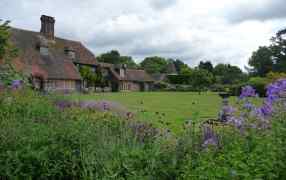
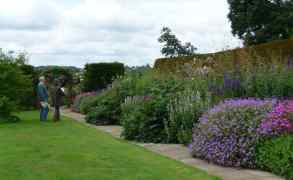
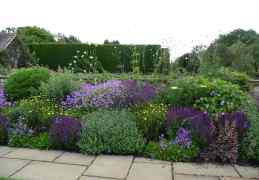 The garden covers an area of three and a quarter acres, which has been divided up into ‘rooms’ by what must have been miles of hornbeam and beech hedges. There is a large lawn and a stunning herbaceous border along one side, with a colour palette of purple and lilac with a touch of yellow. This was certainly at its best. It is backed by a tapestry conifer hedge. On the opposite side of the lawn was another shorter border in a similar colour scheme. This was the only garden we visited without any Allium christophii!!
The garden covers an area of three and a quarter acres, which has been divided up into ‘rooms’ by what must have been miles of hornbeam and beech hedges. There is a large lawn and a stunning herbaceous border along one side, with a colour palette of purple and lilac with a touch of yellow. This was certainly at its best. It is backed by a tapestry conifer hedge. On the opposite side of the lawn was another shorter border in a similar colour scheme. This was the only garden we visited without any Allium christophii!!
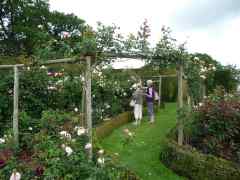
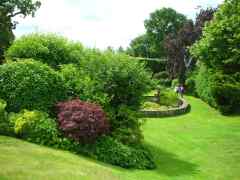
The two rose gardens were both in their prime, one planted in 2001 and the sunken one (which is pre-war in origin) was replanted in 2005. The garden has a total of 700 roses, predominantly David Austin English roses. The Dell, where the old farm pond was situated, now has a fishpond built of knapped flints and is surrounded by shrubs and trees. To the left of the hornbeam walk was the vegetable garden which was immaculate - I can’t believe they ate any of the produce: it would spoil the display!
A herb
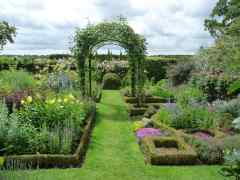
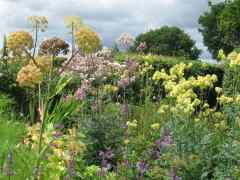 garden was started in 1992 with four main beds edged with box. These contain herbs and cottage garden plants. An adjoining piece of land was acquired in 2001 and has been planted out in hornbeam to represent a Romanesque church, ‘Toune Priory’. This is work in progress but it has already been used for a musical recital, a very theatrical setting.
garden was started in 1992 with four main beds edged with box. These contain herbs and cottage garden plants. An adjoining piece of land was acquired in 2001 and has been planted out in hornbeam to represent a Romanesque church, ‘Toune Priory’. This is work in progress but it has already been used for a musical recital, a very theatrical setting.
We found the secret garden,
which was again enclosed by hedging and contained a camomile bench and a water feature. We didn’t venture into the orchard as that was where the bee hives were but apparently in spring it is full of daffodils.
The garden opens six times a year for the NGS from 12 June until 10 July and is also visited by many groups. It was certainly a summer garden and at its peak: it would be interesting to see it at another time of year!
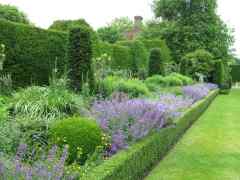 This was our last garden visit before we started our journey back to Worcestershire. Saving the best 'til last was certainly true for me as it was my personal favourite of the trip. Arriving in the rain - nothing unusual - we were welcomed by the owner, Lady Collum, a tiny aristocratic lady of indeterminate age who with one full-time gardener and 'two men to do the hedges' maintains it herself. She has created the garden since the 1950s around a 17th century house. She told us it wasn't a plantsman's garden but one she had planted for a calm and peaceful atmosphere, divided into a series of walks and rooms to represent the various centuries of the house.
This was our last garden visit before we started our journey back to Worcestershire. Saving the best 'til last was certainly true for me as it was my personal favourite of the trip. Arriving in the rain - nothing unusual - we were welcomed by the owner, Lady Collum, a tiny aristocratic lady of indeterminate age who with one full-time gardener and 'two men to do the hedges' maintains it herself. She has created the garden since the 1950s around a 17th century house. She told us it wasn't a plantsman's garden but one she had planted for a calm and peaceful atmosphere, divided into a series of walks and rooms to represent the various centuries of the house.
Large planters filled with scented pelargoniums stood on the terrace; views down the main lawn to the fields and woods beyond, and arched doorways had been cut into the high yew hedges. A ha-ha kept the cattle in their place. Wide herbaceous borders with just blue, white and lemon plantings represented the Victorians and led onto the other areas.
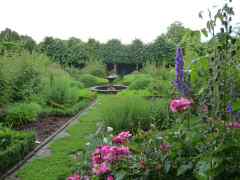
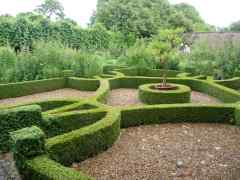
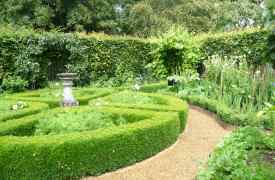 The Herb Garden was the 17th century: all the plants there would have been grown in the 1600s and were for medicinal rather than culinary use. Camomile paths led to a centre fountain and a turf seat was tucked up against a wall. In the Paeony Walk the flowers were over but pale pink roses and various shades of blue clematis still bloomed. Down the Pear Walk, crimson martagon lilies, hostas and later thalictrums flowered.
The Herb Garden was the 17th century: all the plants there would have been grown in the 1600s and were for medicinal rather than culinary use. Camomile paths led to a centre fountain and a turf seat was tucked up against a wall. In the Paeony Walk the flowers were over but pale pink roses and various shades of blue clematis still bloomed. Down the Pear Walk, crimson martagon lilies, hostas and later thalictrums flowered.
The Pre-Raphaelite Walk had been designed around a medieval woodcut picture. Always planted in white, there were roses, clematis and lilies, and in the spring it is full of pheasant's eye narcissus.
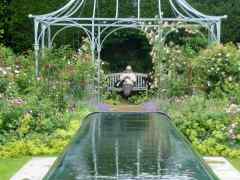
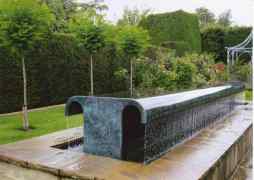
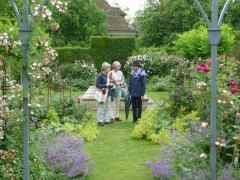 A large rose garden called the Pye Garden after the architect of a very large and noisy water feature was the only area which, for me, didn't quite fit in: roses up obelisks and a very dominant sound of water. Peace would have been much nicer. Philadelphus and hydrangeas and late crinums in shady walks; perfume everywhere one went.
A large rose garden called the Pye Garden after the architect of a very large and noisy water feature was the only area which, for me, didn't quite fit in: roses up obelisks and a very dominant sound of water. Peace would have been much nicer. Philadelphus and hydrangeas and late crinums in shady walks; perfume everywhere one went.
Tea was served in the old stableyard, Lady Collum declining all offers of help and pouring to the whole group from the largest bone china teapot I have ever seen. And the cake was the best I have tasted on a garden visit.